Abstract
An analysis of revertants of missense mutants in phage P22 has shown: (i) New temperature-sensitive (TS) and cold-sensitive (CS) phenotypes are often acquired concomitant with reversion. (ii) In many cases, these new phenotypes are due to second-site mutations (suppressors) that correct the original defect. (iii) Sometimes the suppressor mutation is not in the same gene as the original mutation. (iv) Extragenic suppressors are almost always in genes whose products are known to interact physically with the original gene products. (v) The suppressor mutations typically retain their TS or CS phenotypes when crossed into wild-type genetic backgrounds. (vi) Some TS and CS mutants derived by reversion can themselves be reverted to produce additional mutations. We have shown that genetic reversion of missense mutants can be of value in producing new temperature-sensitive and cold-sensitive mutations affecting related functions. We suggest that our approach can be extended to organisms with large genomes.
Full text
PDF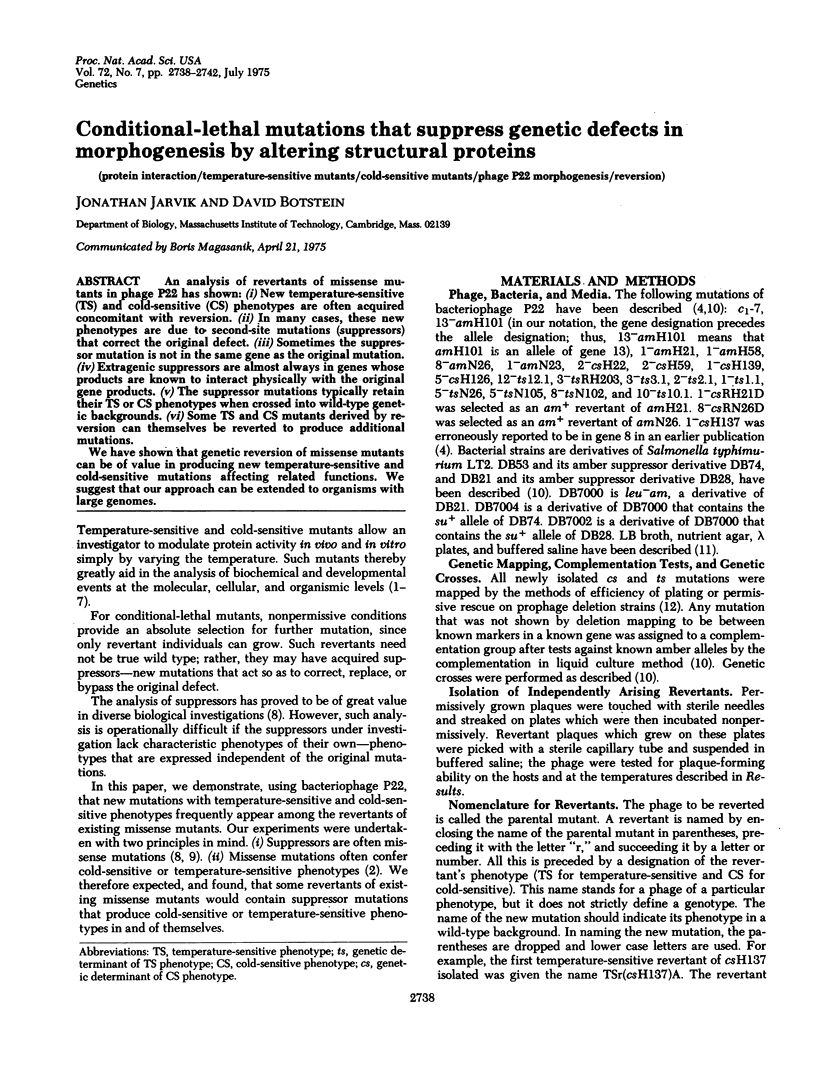
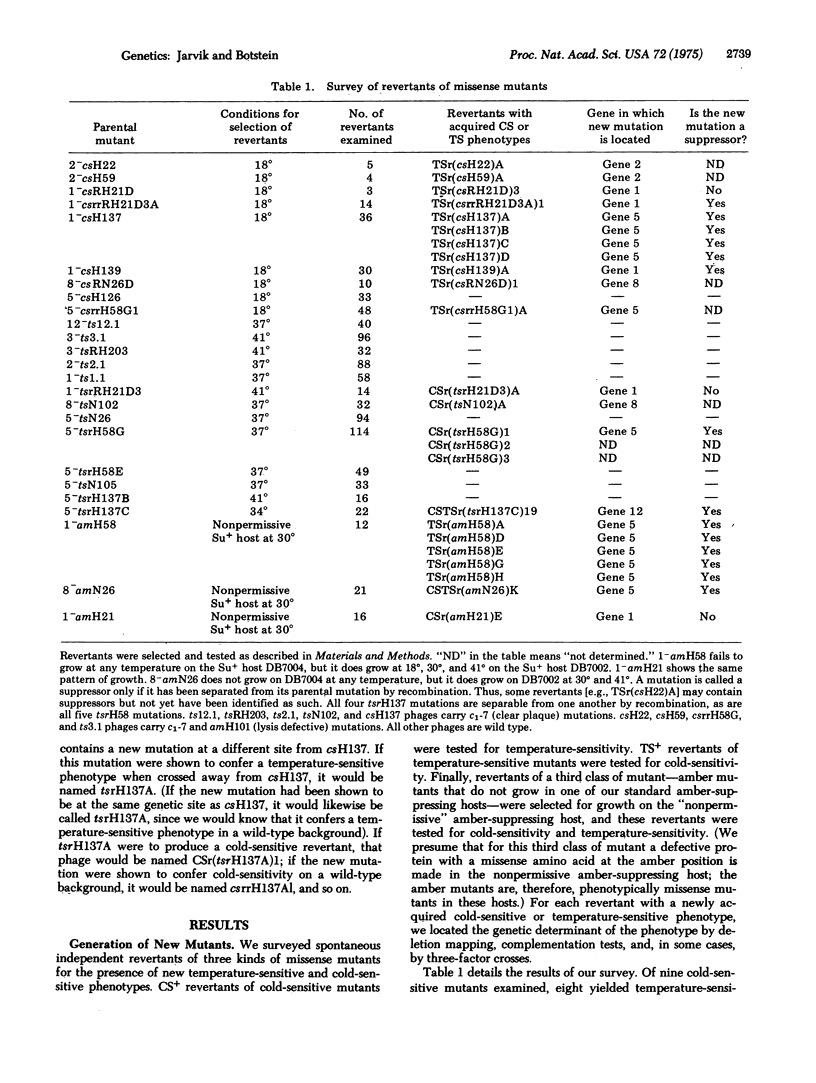
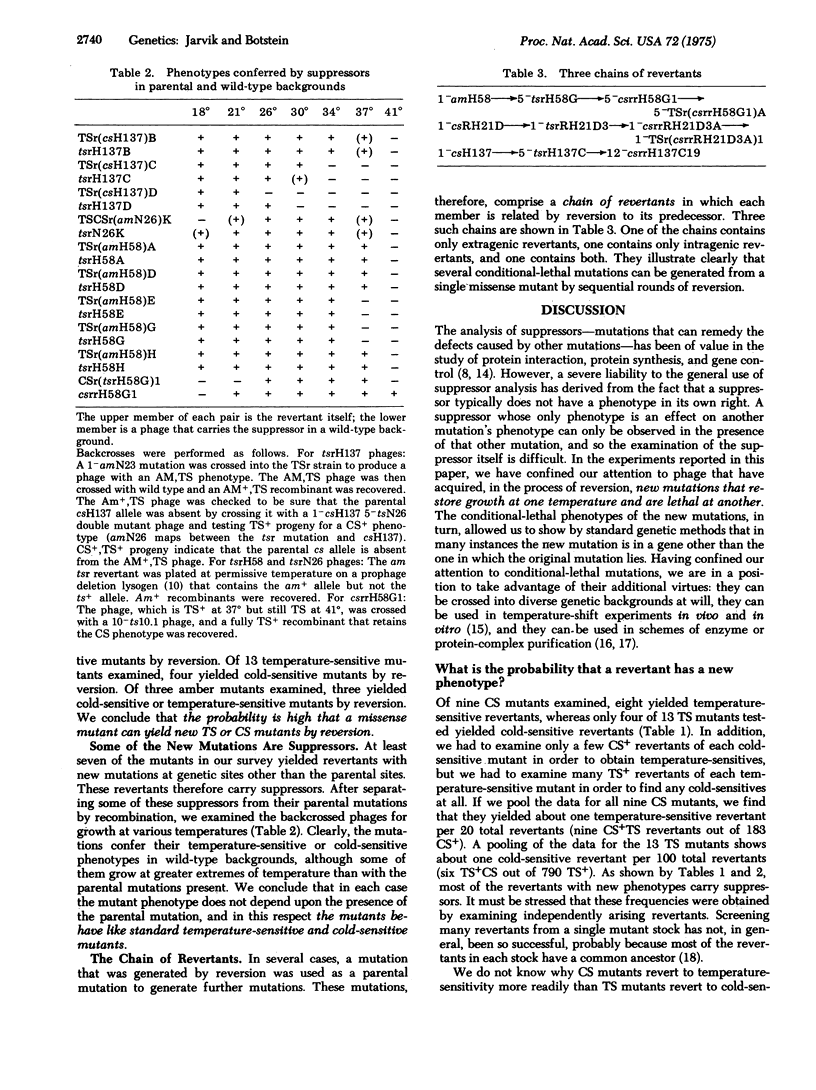
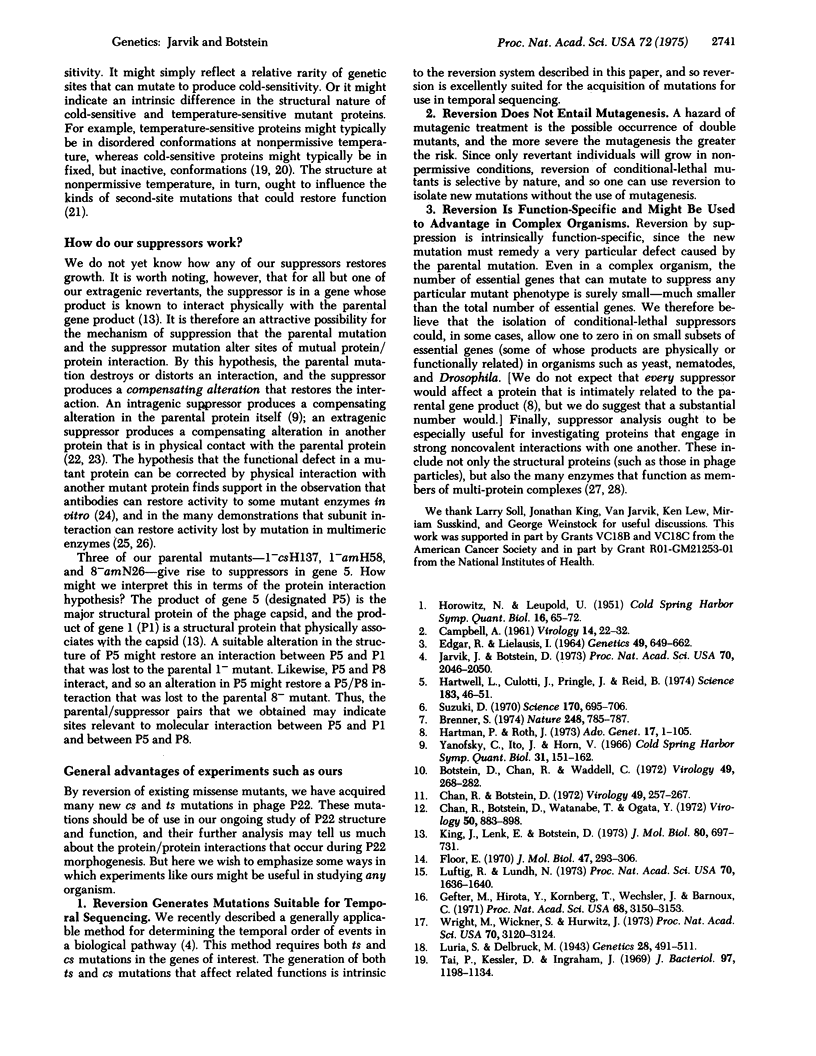
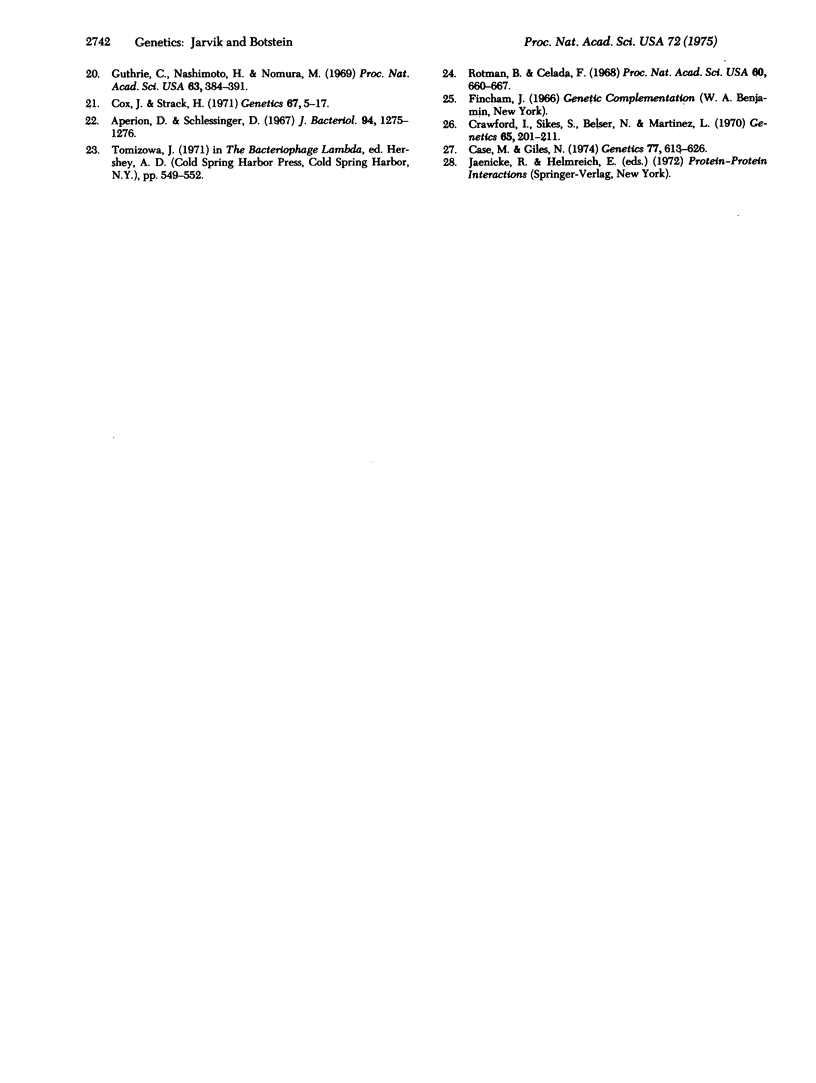
Selected References
These references are in PubMed. This may not be the complete list of references from this article.
- Apirion D., Schlessinger D. Reversion from streptomycin dependence in Escherichia coli by a further change in the ribosome. J Bacteriol. 1967 Oct;94(4):1275–1276. doi: 10.1128/jb.94.4.1275-1276.1967. [DOI] [PMC free article] [PubMed] [Google Scholar]
- Botstein D., Chan R. K., Waddell C. H. Genetics of bacteriophage P22. II. Gene order and gene function. Virology. 1972 Jul;49(1):268–282. doi: 10.1016/s0042-6822(72)80028-x. [DOI] [PubMed] [Google Scholar]
- Brenner S. New directions in molecular biology. Nature. 1974 Apr 26;248(5451):785–787. doi: 10.1038/248785a0. [DOI] [PubMed] [Google Scholar]
- CAMPBELL A. Sensitive mutants of bacteriophage lambda. Virology. 1961 May;14:22–32. doi: 10.1016/0042-6822(61)90128-3. [DOI] [PubMed] [Google Scholar]
- Case M. E., Giles N. H. Revertants and secondary arom-2 mutants induced in non-complementing mutants in the arom gene cluster of Neurospora crassa. Genetics. 1974 Aug;77(4):613–626. doi: 10.1093/genetics/77.4.613. [DOI] [PMC free article] [PubMed] [Google Scholar]
- Chan R. K., Botstein D. Genetics of bacteriophage P22. I. Isolation of prophage deletions which affect immunity to superinfection. Virology. 1972 Jul;49(1):257–267. doi: 10.1016/s0042-6822(72)80027-8. [DOI] [PubMed] [Google Scholar]
- Chan R. K., Botstein D., Watanabe T., Ogata Y. Specialized transduction of tetracycline resistance by phage P22 in Salmonella typhimurium. II. Properties of a high-frequency-transducing lysate. Virology. 1972 Dec;50(3):883–898. doi: 10.1016/0042-6822(72)90442-4. [DOI] [PubMed] [Google Scholar]
- Cox J. H., Strack H. B. Cold-sensitive mutants of bacteriophage lambda. Genetics. 1971 Jan;67(1):5–17. doi: 10.1093/genetics/67.1.5. [DOI] [PMC free article] [PubMed] [Google Scholar]
- Crawford I. P., Sikes S., Belser N. O., Martinez L. Mutants of Escherichia coli defective in the B protein of tryptophan synthetase. 3. Intragenic clustering. Genetics. 1970 Jun;65(2):201–211. doi: 10.1093/genetics/65.2.201. [DOI] [PMC free article] [PubMed] [Google Scholar]
- EDGAR R. S., LIELAUSIS I. TEMPERATURE-SENSITIVE MUTANTS OF BACTERIOPHAGE T4D: THEIR ISOLATION AND GENETIC CHARACTERIZATION. Genetics. 1964 Apr;49:649–662. doi: 10.1093/genetics/49.4.649. [DOI] [PMC free article] [PubMed] [Google Scholar]
- Floor E. Interaction of morphogenetic genes of bacteriophage T4. J Mol Biol. 1970 Feb 14;47(3):293–306. doi: 10.1016/0022-2836(70)90303-7. [DOI] [PubMed] [Google Scholar]
- Gefter M. L., Hirota Y., Kornberg T., Wechsler J. A., Barnoux C. Analysis of DNA polymerases II and 3 in mutants of Escherichia coli thermosensitive for DNA synthesis. Proc Natl Acad Sci U S A. 1971 Dec;68(12):3150–3153. doi: 10.1073/pnas.68.12.3150. [DOI] [PMC free article] [PubMed] [Google Scholar]
- Guthrie C., Nashimoto H., Nomura M. Structure and function of E. coli ribosomes. 8. Cold-sensitive mutants defective in ribosome assembly. Proc Natl Acad Sci U S A. 1969 Jun;63(2):384–391. doi: 10.1073/pnas.63.2.384. [DOI] [PMC free article] [PubMed] [Google Scholar]
- HOROWITZ N. H., LEUPOLD U. Some recent studies bearing on the one geneone enzyme hypothesis. Cold Spring Harb Symp Quant Biol. 1951;16:65–74. doi: 10.1101/sqb.1951.016.01.006. [DOI] [PubMed] [Google Scholar]
- Hartman P. E., Roth J. R. Mechanisms of suppression. Adv Genet. 1973;17:1–105. doi: 10.1016/s0065-2660(08)60170-4. [DOI] [PubMed] [Google Scholar]
- Hartwell L. H., Culotti J., Pringle J. R., Reid B. J. Genetic control of the cell division cycle in yeast. Science. 1974 Jan 11;183(4120):46–51. doi: 10.1126/science.183.4120.46. [DOI] [PubMed] [Google Scholar]
- Jarvik J., Botstein D. A genetic method for determining the order of events in a biological pathway. Proc Natl Acad Sci U S A. 1973 Jul;70(7):2046–2050. doi: 10.1073/pnas.70.7.2046. [DOI] [PMC free article] [PubMed] [Google Scholar]
- Johnson E. J., Abraham S. Assimilation and metabolism of exogenous organic compounds by the strict autotrophs Thiobacillus thioparus and Thiobacillus neapolitanus. J Bacteriol. 1969 Mar;97(3):1198–1208. doi: 10.1128/jb.97.3.1198-1208.1969. [DOI] [PMC free article] [PubMed] [Google Scholar]
- King J., Lenk E. V., Botstein D. Mechanism of head assembly and DNA encapsulation in Salmonella phage P22. II. Morphogenetic pathway. J Mol Biol. 1973 Nov 15;80(4):697–731. doi: 10.1016/0022-2836(73)90205-2. [DOI] [PubMed] [Google Scholar]
- Luftig R. B., Lundh N. P. Bacteriophage T4 head morphogenesis. Isolation, partial characterization, and fate of gene 21-defective tau-particles. Proc Natl Acad Sci U S A. 1973 Jun;70(6):1636–1640. doi: 10.1073/pnas.70.6.1636. [DOI] [PMC free article] [PubMed] [Google Scholar]
- Luria S. E., Delbrück M. Mutations of Bacteria from Virus Sensitivity to Virus Resistance. Genetics. 1943 Nov;28(6):491–511. doi: 10.1093/genetics/28.6.491. [DOI] [PMC free article] [PubMed] [Google Scholar]
- Rotman M. B., Celada F. Antibody-mediated activation of a defective beta-D-galactosidase extracted from an Escherichia coli mutant. Proc Natl Acad Sci U S A. 1968 Jun;60(2):660–667. doi: 10.1073/pnas.60.2.660. [DOI] [PMC free article] [PubMed] [Google Scholar]
- Suzuki D. T. Temperature-sensitive mutations in Drosophila melanogaster. Science. 1970 Nov 13;170(3959):695–706. doi: 10.1126/science.170.3959.695. [DOI] [PubMed] [Google Scholar]
- Wright M., Wickner S., Hurwitz J. Studies on in vitro DNA synthesis. Isolation of DNA B gene product from Escherichia coli. Proc Natl Acad Sci U S A. 1973 Nov;70(11):3120–3124. doi: 10.1073/pnas.70.11.3120. [DOI] [PMC free article] [PubMed] [Google Scholar]
- Yanofsky C., Ito J., Horn V. Amino acid replacements and the genetic code. Cold Spring Harb Symp Quant Biol. 1966;31:151–162. doi: 10.1101/sqb.1966.031.01.023. [DOI] [PubMed] [Google Scholar]


